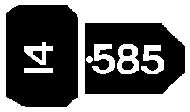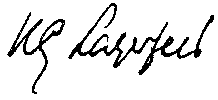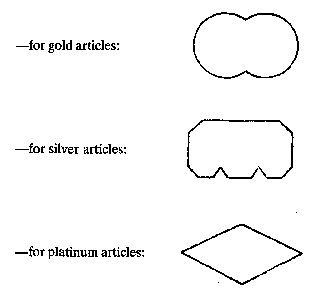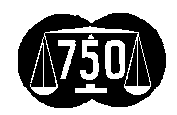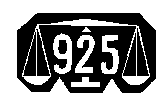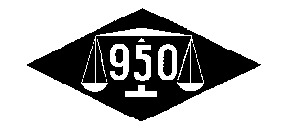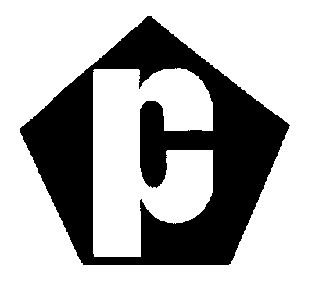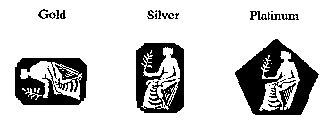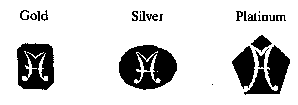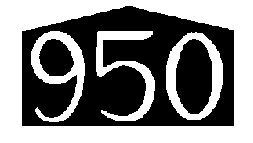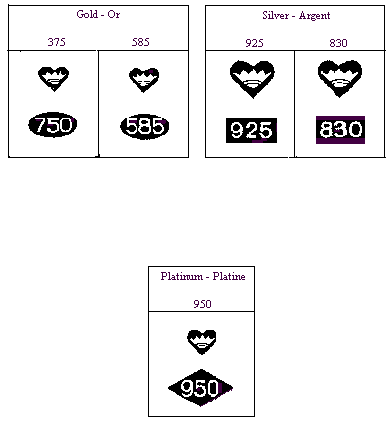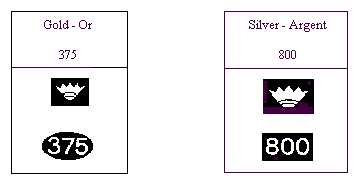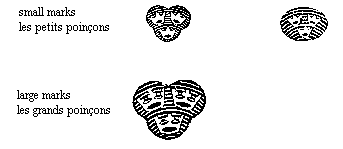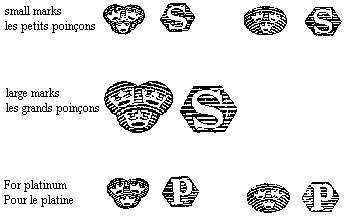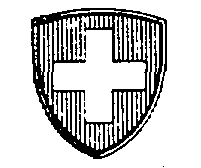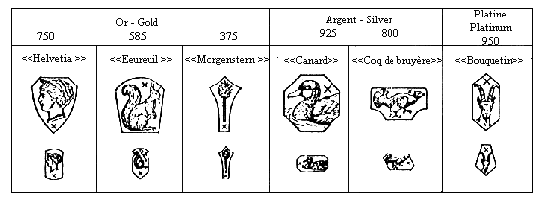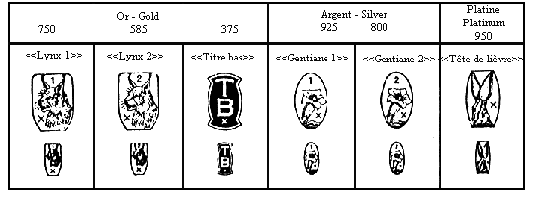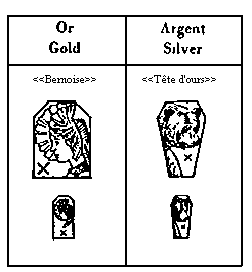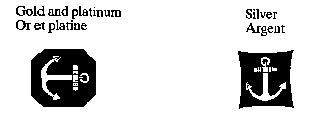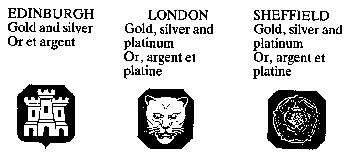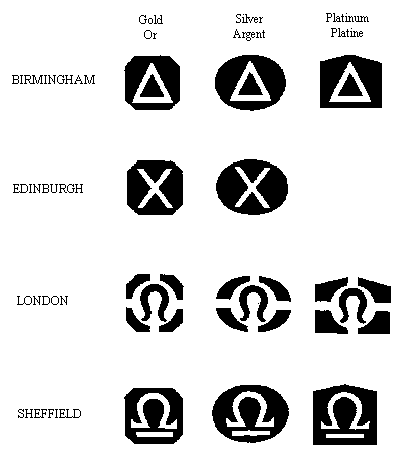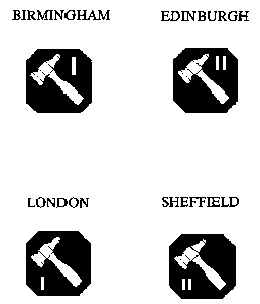S.I. No. 327/1983 - Hallmarking (Approved Hallmarks) Regulations, 1983.
S.I. No. 327 of 1983. | ||||||||||||||||||||||||||||||||||||||
HALLMARKING (APPROVED HALLMARKS) REGULATIONS, 1983. | ||||||||||||||||||||||||||||||||||||||
I, FRANK CLUSKEY, Minister for Trade, Commerce and Tourism, in exercise of the powers conferred on me by section 3 of the Hallmarking Act, 1981 (No. 18 of 1981), and the Industry, Commerce and Tourism (Alteration of Name of Department and Title of Minister) Order, 1981 ( S.I. No. 290 of 1981 ), and after consultation with the Company referred to in the said section 3, hereby make the following Regulations:— 1. These Regulations may be cited as the Hallmarking (Approved Hallmarks) Regulations, 1983, and shall come into operation on the 8th day of November, 1983. 2. (1) In these Regulations— | ||||||||||||||||||||||||||||||||||||||
"the Common Control Mark" means the mark described in paragraph 8 of Annex II to the Convention; | ||||||||||||||||||||||||||||||||||||||
"the Company" has the meaning assigned to it by the Hallmarking Act, 1981 ; | ||||||||||||||||||||||||||||||||||||||
"the Convention" means the Convention on the Control and Marking of Articles of Precious Metals, done at Vienna on the 15th day of November, 1972, to which the State is a party, and a copy of which is set out in Schedule 1; | ||||||||||||||||||||||||||||||||||||||
"the Dublin Assay Office" means the assay office of the Company. | ||||||||||||||||||||||||||||||||||||||
(2) References in these Regulations to standards of fineness are to the standards of fineness prescribed by the Hallmarking (Irish Standards of Fineness) Regulations, 1983 ( S.I. No. 328 of 1983 ). | ||||||||||||||||||||||||||||||||||||||
(3) A reference in these Regulations to a Schedule is to a Schedule to these Regulations. 3. In addition to the fineness marks referred to in the Charter and in sections 3 to 5 of the Plate Assay Act, 1783, the following fineness marks are hereby prescribed as approved hallmarks to be applied to articles of precious metal consisting of or containing gold and comprising gold vessel, gold plate or manufacture of gold: | ||||||||||||||||||||||||||||||||||||||
( a ) where such an article is of the standard of fineness of 14 carats, a mark consisting of the figure "14" in a rectangular shield with chamfered corners and the decimal marks ".585" in a rectangular shield with chamfered corners at one side, illustrated as follows:— | ||||||||||||||||||||||||||||||||||||||
| ||||||||||||||||||||||||||||||||||||||
(b) where such an article is of the standard of fineness of 9 carats, a mark consisting of the figure "9" in a rectangular shield with chamfered corners and the decimal marks ".375" in a rectangular shield with chamfered corners at one side, illustrated as follows:— | ||||||||||||||||||||||||||||||||||||||
4. (1) The following fineness mark, that is to say, a mark consisting of the letter "P" with a broken loop and set in a pentagonal shield, and illustrated in Schedule 2, is hereby prescribed as an approved hallmark to be applied to every article of precious metal consisting of or containing platinum manufactured or wrought in the State to the standard of fineness of 950 parts in every 1,000 parts. | ||||||||||||||||||||||||||||||||||||||
(2) The following fineness mark, that is to say, a mark consisting of the appropriate arabic numerals in a pentagonal shield, and illustrated in Schedule 4, is hereby prescribed as an approved hallmark to be applied to every article of precious metal, not being an article controlled by the Convention, consisting of or containing platinum imported into the State and manufactured or wrought to the standard of fineness of 950 parts in every 1,000 parts. 5. The following marks are hereby prescribed as approved hallmarks to be applied to all articles of precious metal other than imported articles to which international hallmarks have already been applied: | ||||||||||||||||||||||||||||||||||||||
( a ) the appropriate mark used by the Dublin Assay Office, and illustrated in Schedule 3, that is to say: | ||||||||||||||||||||||||||||||||||||||
(i) for articles of gold and silver manufactured in the State, the figure of Hibernia in a rectangular shield with chamfered corners; | ||||||||||||||||||||||||||||||||||||||
(ii) for articles of platinum manufactured in the State, the figure of Hibernia in a pentagonal shield; | ||||||||||||||||||||||||||||||||||||||
(iii) for articles imported into the State other than articles to which international hallmarks have been applied: | ||||||||||||||||||||||||||||||||||||||
—a boujet in a rectangular shield with chamfered corners for gold, | ||||||||||||||||||||||||||||||||||||||
—a boujet in an elliptical shield for silver, | ||||||||||||||||||||||||||||||||||||||
—a boujet in a pentagonal shield for platinum; | ||||||||||||||||||||||||||||||||||||||
( b ) a mark denoting the relevant standard of fineness and applied in the Dublin Assay Office; | ||||||||||||||||||||||||||||||||||||||
( c ) a mark or letter denoting the year of manufacture of the article or the year of hallmarking of the article and (in each case) applied in the Dublin Assay Office. 6. A person who brings or causes to be brought to the Dublin Assay Office an article of precious metal consisting of platinum imported into the State for an application to the article of a mark prescribed by Regulation 4 or 5 of these Regulations shall duly complete a statement in the form set out in the Second Schedule to the Hallmarking of Imported Plate Order, 1935 (S. R. & O., No. 254 of 1935), and that form shall from the commencement of these Regulations apply to gold, silver and platinum. 7. The following marks are hereby prescribed as international hallmarks: | ||||||||||||||||||||||||||||||||||||||
( a ) a mark which has been notified in accordance with the Convention as being the mark of an assay office authorised for purposes of the Convention in the territory of a Contracting State (other than the State) and illustrated in Schedule 5; | ||||||||||||||||||||||||||||||||||||||
( b ) a mark consisting of the Common Control Mark applied in an assay office referred to in paragraph (a) of this Regulation or in the Dublin Assay Office. | ||||||||||||||||||||||||||||||||||||||
Regulation 2 (1) | ||||||||||||||||||||||||||||||||||||||
|
SCHEDULE 1 | ||||||||||||||||||||||||||||||||||||||
CONVENTION ON THE CONTROL AND MARKING OF ARTICLES OF PRECIOUS METALS | ||||||||||||||||||||||||||||||||||||||
PREAMBLE | ||||||||||||||||||||||||||||||||||||||
The Republic of Austria, the Republic of Finland, the Kingdom of Norway, the Portuguese Republic, the Kingdom of Sweden, the Swiss Confederation and the United Kingdom of Great Britain and Northern Ireland; | ||||||||||||||||||||||||||||||||||||||
Desiring to facilitate international trade in articles of precious metals while at the same time maintaining consumer protection justified by the particular nature of these articles; | ||||||||||||||||||||||||||||||||||||||
Have agreed as follows: | ||||||||||||||||||||||||||||||||||||||
I SCOPE AND OPERATION | ||||||||||||||||||||||||||||||||||||||
ARTICLE 1 | ||||||||||||||||||||||||||||||||||||||
1. Legal provisions of a Contracting State which require articles of precious metals to be assayed by an authorized body and to be marked with official stamps so as to indicate that they have been satisfactorily assayed, or require such articles to be marked so as to indicate the sponsor, the nature of the metal or the standard of fineness, shall be deemed to be satisfied in respect of articles of precious metals imported from the territory of another Contracting State if such articles have been controlled and marked in accordance with the provisions of this Convention. | ||||||||||||||||||||||||||||||||||||||
2. For articles controlled and marked in accordance with the provisions of this Convention an importing Contracting State shall not require further assaying or marking of a kind referred to in paragraph 1, except for the purpose of check tests as provided in Article 6. | ||||||||||||||||||||||||||||||||||||||
3. Nothing in this Convention shall require a Contracting State to allow the importation or sale of articles of precious metals which do not fulfil its national minimum standards of fineness. Furthermore, nothing in this Convention shall require a Contracting State which accepts 800 as a standard of fineness for silver to allow the importation or sale of articles marked with the 830 standard of fineness. | ||||||||||||||||||||||||||||||||||||||
ARTICLE 2 | ||||||||||||||||||||||||||||||||||||||
For the purposes of this Convention "articles of precious metals" means articles of silver, gold, platinum or alloys thereof, as defined in Annex I. | ||||||||||||||||||||||||||||||||||||||
ARTICLE 3 | ||||||||||||||||||||||||||||||||||||||
1. In order to benefit from the provisions of Article 1, articles of precious metals must be: | ||||||||||||||||||||||||||||||||||||||
( a ) submitted to an authorized assay office appointed in accordance with Article 5; | ||||||||||||||||||||||||||||||||||||||
( b ) controlled by the authorized assay office in accordance with the rules and procedures laid down in Annexes I and II; | ||||||||||||||||||||||||||||||||||||||
( c ) marked with the marks as prescribed in Annex II, including the Common Control Mark as described in paragraph 8 thereof. | ||||||||||||||||||||||||||||||||||||||
2. The benefits of Article 1 shall not be applicable to articles of precious metals which, after being marked as prescribed in Annex II have had any of these marks altered or obliterated. | ||||||||||||||||||||||||||||||||||||||
ARTICLE 4 | ||||||||||||||||||||||||||||||||||||||
The Contracting States shall not be obliged to apply the provisions of paragraphs 1 and 2 of Article 1 to articles of precious metals which since being submitted to an authorized assay office, and controlled and marked as prescribed in Article 3 have been altered by addition or in any other manner. | ||||||||||||||||||||||||||||||||||||||
II CONTROL AND SANCTIONS | ||||||||||||||||||||||||||||||||||||||
ARTICLE 5 | ||||||||||||||||||||||||||||||||||||||
1. Each Contracting State shall appoint one or more assay offices which shall be the only bodies authorized in its territory to carry out the control of articles of precious metals provided for in this Convention and to apply its own appointed assay office mark and the Common Control Mark. | ||||||||||||||||||||||||||||||||||||||
2. Each Contracting State shall notify the depositary of the appointment of such authorized assay offices and of their assay office marks and any withdrawal of this authorization from any assay office previously appointed. The depositary shall immediately notify all other Contracting States accordingly. | ||||||||||||||||||||||||||||||||||||||
ARTICLE 6 | ||||||||||||||||||||||||||||||||||||||
The provisions of this Convention shall not prevent a Contracting State from carrying out check tests on articles of precious metals bearing the marks provided for in this Convention. Such tests shall not be carried out in such a way as to hamper unduly the importation or sale of articles of precious metals marked in conformity with the provisions of this Convention. | ||||||||||||||||||||||||||||||||||||||
ARTICLE 7 | ||||||||||||||||||||||||||||||||||||||
The Contracting States hereby empower the depositary to register with the World Intellectual Property Organization (WIPO), in accordance with the Convention of Paris for the Protection of Industrial Property, the Common Control Mark as a national hall-mark of each Contracting State. The depositary shall also do so in the case of a Contracting State in relation to which this Convention enters into force at a later date or in the case of an acceding State. | ||||||||||||||||||||||||||||||||||||||
ARTICLE 8 | ||||||||||||||||||||||||||||||||||||||
1. Each Contracting State shall have and maintain legislation prohibiting subject to penalties, any forgery or misuse of the Common Control Mark provided for by this Convention or of the marks of the authorized assay offices which have been notified in accordance with paragraph 2 of Article 5, and any unauthorized alteration to the article or alteration or obliteration of the fineness mark or responsibility mark after the Common Control Mark has been applied. | ||||||||||||||||||||||||||||||||||||||
2. Each Contracting State undertakes to institute proceedings under such legislation when sufficient evidence of forgery or misuse of the Common Control Mark or marks of the authorized assay offices, or unauthorized alteration to the article or alteration or obliteration of the fineness mark or responsibility mark after the Common Control Mark has been applied is discovered or brought to its attention by another Contracting State or, where more appropriate, to take other suitable action. | ||||||||||||||||||||||||||||||||||||||
ARTICLE 9 | ||||||||||||||||||||||||||||||||||||||
1. If an importing Contracting State or one of its assay offices has reason to believe that an assay office of an exporting Contracting State has affixed the Common Control Mark without having complied with the relevant provisions of this Convention, the assay office by which the articles are purported to have been marked shall be immediately consulted, and the latter assay office shall promptly lend all reasonable assistance for the investigation of the case. If no satisfactory settlement is reached, either of the parties may refer the case to the Standing Committee by notifying its Chairman. In such a case the Chairman shall convene a meeting of the Standing Committee not later than one month from the receipt of such notification. | ||||||||||||||||||||||||||||||||||||||
2. If any matter has been referred to the Standing Committee under paragraph 1, the Standing Committee may, after having given an opportunity for the parties concerned to be heard, make recommendations as to the appropriate action to be taken. | ||||||||||||||||||||||||||||||||||||||
3. If within a reasonable time a recommendation referred to in paragraph 2 has not been complied with, or the Standing Committee has failed to make any recommendation, the importing Contracting State may then introduce such additional surveillance of articles of precious metals marked by that particular assay office and entering its territory, as it considers necessary, including the right temporarily to refuse to accept such articles. Such measures shall immediately be notified to all Contracting States and shall be reviewed from time to time by the Standing Committee. | ||||||||||||||||||||||||||||||||||||||
4. Where there is evidence of repeated and grave misapplication of the Common Control Mark the importing Contracting State may temporarily refuse to accept articles bearing the assay office mark of the assay office concerned whether or not controlled and marked in accordance with this Convention. In such a case the importing Contracting State shall immediately notify all other Contracting States and the Standing Committee shall meet within one month to consider the matter. | ||||||||||||||||||||||||||||||||||||||
III STANDING COMMITTEE AND AMENDMENTS | ||||||||||||||||||||||||||||||||||||||
ARTICLE 10 | ||||||||||||||||||||||||||||||||||||||
1. A Standing Committee is hereby established on which each Contracting State shall be represented. Each Contracting State shall have one vote. | ||||||||||||||||||||||||||||||||||||||
2. The tasks of the Standing Committee shall be: | ||||||||||||||||||||||||||||||||||||||
to consider and review the operation of this Convention; | ||||||||||||||||||||||||||||||||||||||
to promote technical and administrative co-operation between the Contracting States in matters dealt with by this Convention; | ||||||||||||||||||||||||||||||||||||||
to consider measures for securing uniform interpretation and application of the provisions of this Convention; | ||||||||||||||||||||||||||||||||||||||
to encourage the adequate protection of the marks against forgery and misuse; | ||||||||||||||||||||||||||||||||||||||
to make recommendations in the case of any matter referred to it under the provisions of paragraph 2 of Article 9, or for the settlement of any dispute arising out of the operation of this Convention which is presented to the Standing Committee. | ||||||||||||||||||||||||||||||||||||||
3. The Standing Committee shall adopt rules of procedure for its meeting including rules for the convening of such meetings. This Committee shall meet at least once a year. The first meeting shall be convened by the depositary not later than six months after the coming into force of this Convention. | ||||||||||||||||||||||||||||||||||||||
4. The Standing Committee may make recommendations on any question relating to the implementation of this Convention or make proposals for the amendment of this Convention or its Annexes. Such recommendations or proposals shall be transmitted to the depositary who shall notify all Contracting States. | ||||||||||||||||||||||||||||||||||||||
ARTICLE 11 | ||||||||||||||||||||||||||||||||||||||
1. In the case of a proposal received from the Standing Committee for amendment of the Annexes to the Convention the depositary shall notify all Contracting States and invite their Governments to give their consent to the proposed amendment within four months. Such consent may be conditional in order to meet internal constitutional requirements. | ||||||||||||||||||||||||||||||||||||||
2. Unless a negative reply has been received from the Government of a Contracting State within the period mentioned in paragraph 1, the amendment to the Annexes shall come into force six months after the expiration of this period unless a later date for its entry into force has been provided for in the amendment, and provided that the conditions in any consent referred to in paragraph 1 have been fulfilled. The depositary shall notify the entry into force and the relevant date to all Contracting States. | ||||||||||||||||||||||||||||||||||||||
3. In the case of a proposal received from the Standing Committee for the amendment of the Articles to the Convention, or in the case of a proposal for amendment of the Convention or its Annexes received from a Contracting State, the depositary shall submit such proposals for acceptance to all Contracting States. | ||||||||||||||||||||||||||||||||||||||
4. If within three months from the date of the submission of a proposal for amendment under paragraph 3 a Contracting State requests that negotiations be opened on the proposal, the depositary shall arrange for such negotiations to be held. | ||||||||||||||||||||||||||||||||||||||
5. Provided it is accepted by all Contracting States, an amendment to this Convention or its Annexes proposed under paragraph 3 shall enter into force one month after deposit of the last instrument of acceptance unless another date is provided for in the amendment. Instruments of acceptance shall be deposited with the depositary who shall notify all Contracting States. | ||||||||||||||||||||||||||||||||||||||
IV FINAL PROVISIONS | ||||||||||||||||||||||||||||||||||||||
ARTICLE 12 | ||||||||||||||||||||||||||||||||||||||
1. This Convention is open to accession by any State being a Member of the United Nations or of any of the specialized agencies or of the International Atomic Energy Agency or a Party to the Statute of the International Court of Justice and having arrangements for the assay and marking of articles of precious metals necessary to comply with the requirements of this Convention. | ||||||||||||||||||||||||||||||||||||||
2. Requests for accession expressing willingness to accept the obligations under this Convention, together with a description of the assay offices which the requesting State proposes to appoint in accordance with Article 5, shall be addressed to the depositary who shall notify the Governments of all Contracting States and ask them to consent to the accession. | ||||||||||||||||||||||||||||||||||||||
3. The Governments of the Contracting States shall base their decision whether to consent to the accession solely on the technical competence and the reliability of the assay office described in the request for accession and on the existence of arrangements necessary to comply with the provisions of Article 8. | ||||||||||||||||||||||||||||||||||||||
4. The Governments shall notify their reply to the depositary within four months after receipt of the notification of a request for accession. Any Government not replying within that period shall be deemed to have consented to the accession. The depositary shall inform the Governments of the requesting State and of the Contracting States whether the request for accession has received general consent. | ||||||||||||||||||||||||||||||||||||||
5. Provided that the Governments of all Contracting States have consented to the accession, the requesting State may accede to this Convention by depositing an instrument of accession with the depositary which shall notify all other Contracting States. The accession shall become effective three months after deposit of that instrument. | ||||||||||||||||||||||||||||||||||||||
ARTICLE 13 | ||||||||||||||||||||||||||||||||||||||
The Kingdom of Denmark and the Republic of Iceland, which participated in the drafting of this Convention, may accede to it by depositing an instrument of accession with the depositary. The accession shall become effective two months after the date of deposit of that instrument, but not before the expiry of the period of four months mentioned in paragraph 2 of Article 16. | ||||||||||||||||||||||||||||||||||||||
ARTICLE 14 | ||||||||||||||||||||||||||||||||||||||
1. The Government of any signatory or acceding State may, when depositing its instrument of ratification or accession, or at any time thereafter, declare in writing to the depositary that this Convention shall apply to all or part of the territories, designated in the declaration, for the external relations of which it is responsible. The depositary shall communicate any such declaration to the Governments of all other Contracting States. | ||||||||||||||||||||||||||||||||||||||
2. If the declaration was made at the time of the deposit of the instrument of ratification or accession this Convention shall enter into force in relation to those territories on the same date as the Convention enters into force in relation to the State having made the declaration. In all other cases the Convention shall enter into force in relation to those territories three months after the declaration has been received by the depositary. | ||||||||||||||||||||||||||||||||||||||
3. The application of this Convention to all or part of such territories may be terminated by the Government of the State having made the declaration referred to in paragraph 1 provided that it gives three months' notice in writing to the depositary which shall notify all other Contracting States. | ||||||||||||||||||||||||||||||||||||||
ARTICLE 15 | ||||||||||||||||||||||||||||||||||||||
Any Contracting State may withdraw from this Convention provided that it gives twelve months' notice in writing to the depositary who shall notify all Contracting States, or on such other terms as may be agreed upon by the Contracting States. Each Contracting State undertakes that, in the event of its withdrawal from the Convention, it will cease after withdrawal to use or apply the Common Control Mark for any purpose. | ||||||||||||||||||||||||||||||||||||||
ARTICLE 16 | ||||||||||||||||||||||||||||||||||||||
1. This Convention shall be ratified by the signatory States. The instruments of ratification shall be deposited with the depositary which shall notify all other signatory States. | ||||||||||||||||||||||||||||||||||||||
2. This Convention shall enter into force four months after deposit of the fourth instrument of ratification. In relation to any other signatory State depositing subsequently its instrument of ratification this Convention shall enter into force two months after the date of deposit but not before the expiry of the above-mentioned period of four months. | ||||||||||||||||||||||||||||||||||||||
In witness whereof the undersigned, duly authorized thereto, have signed the present Convention. | ||||||||||||||||||||||||||||||||||||||
Done at Vienna, this fifteenth day of November 1972 in a single copy in the English and French languages, both texts being equally authentic, which shall be deposited with the Government of Sweden, by which certified copies shall be transmitted to all other signatory and acceding States. | ||||||||||||||||||||||||||||||||||||||
| ||||||||||||||||||||||||||||||||||||||
| ||||||||||||||||||||||||||||||||||||||
(Dr. Rudolf Martins) | ||||||||||||||||||||||||||||||||||||||
| ||||||||||||||||||||||||||||||||||||||
| ||||||||||||||||||||||||||||||||||||||
(Klaus A. Sahlgren) | ||||||||||||||||||||||||||||||||||||||
| ||||||||||||||||||||||||||||||||||||||
| ||||||||||||||||||||||||||||||||||||||
(Niels I. Dahl) | ||||||||||||||||||||||||||||||||||||||
| ||||||||||||||||||||||||||||||||||||||
| ||||||||||||||||||||||||||||||||||||||
(Antonio de Siqueira Freire) | ||||||||||||||||||||||||||||||||||||||
In witness whereof the undersigned, duly authorized thereto, have signed the present Convention. | ||||||||||||||||||||||||||||||||||||||
Done at Vienna, this fifteenth day of November 1972 in a single copy in the English and French languages, both texts being equally authentic, which shall be deposited with the Government of Sweden, by which certified copies shall be transmitted to all other signatory and acceding States. | ||||||||||||||||||||||||||||||||||||||
| ||||||||||||||||||||||||||||||||||||||
| ||||||||||||||||||||||||||||||||||||||
(K.G. Lagerfelt) | ||||||||||||||||||||||||||||||||||||||
| ||||||||||||||||||||||||||||||||||||||
| ||||||||||||||||||||||||||||||||||||||
(P. Languetin) | ||||||||||||||||||||||||||||||||||||||
| ||||||||||||||||||||||||||||||||||||||
| ||||||||||||||||||||||||||||||||||||||
(Frederick Mason) | ||||||||||||||||||||||||||||||||||||||
ANNEX I | ||||||||||||||||||||||||||||||||||||||
DEFINITIONS AND TECHNICAL REQUIREMENTS | ||||||||||||||||||||||||||||||||||||||
1. For the purposes of this Convention articles of precious metals means articles consisting of or containing gold, silver, platinum or their alloys and complete as to all their metallic parts, but excluding the following: | ||||||||||||||||||||||||||||||||||||||
( a ) articles consisting of alloys of a fineness less than 375 for gold, 800 for silver or 950 for platinum; | ||||||||||||||||||||||||||||||||||||||
( b ) parts or incomplete semi-manufactures; | ||||||||||||||||||||||||||||||||||||||
( c ) raw materials including bars, plates, sheets, foils, rods, wire, strips and tubes. | ||||||||||||||||||||||||||||||||||||||
Standards of fineness | ||||||||||||||||||||||||||||||||||||||
2. The following standards of fineness shall be recognised for the purpose of this Convention: | ||||||||||||||||||||||||||||||||||||||
( a ) for gold, 750, 585 and 375; | ||||||||||||||||||||||||||||||||||||||
( b ) for silver, 925, 830 and 800; | ||||||||||||||||||||||||||||||||||||||
( c ) for platinum, 950. | ||||||||||||||||||||||||||||||||||||||
3. "Fineness" means the number of parts by weight of fine gold or silver or platinum in 1,000 parts by weight of alloy. | ||||||||||||||||||||||||||||||||||||||
4. The standard of fineness of any article of precious metal, which is of a fineness higher than a standard for that metal mentioned in paragraph 2 shall for the purposes of this Convention be regarded as being of the nearest lower standard as defined in that paragraph. | ||||||||||||||||||||||||||||||||||||||
5. The fineness of all parts of the article, excluding solder and such parts as are permitted under paragraphs 7 to 14, shall be not less than the standard of fineness for the article concerned. | ||||||||||||||||||||||||||||||||||||||
The use of solder | ||||||||||||||||||||||||||||||||||||||
6. Standards of fineness of solder shall be as follows: | ||||||||||||||||||||||||||||||||||||||
( a ) Gold The solder for gold articles shall be of the same standard of fineness as the article concerned, subject to the following exceptions: | ||||||||||||||||||||||||||||||||||||||
In the case of gold articles of filigree work and watch cases of the 750 standard, the solder shall contain not less than 740 parts of gold per 1,000. For white gold articles of the 750 standard the solder shall contain not less than 585 parts of gold per 1,000. | ||||||||||||||||||||||||||||||||||||||
( b ) Silver Solder for silver shall contain not less than 650 parts of silver per 1,000. | ||||||||||||||||||||||||||||||||||||||
( c ) Platinum Solder for platinum shall contain at least 995 parts per 1,000 of gold, silver, platinum or palladium. | ||||||||||||||||||||||||||||||||||||||
Solder which is below the standard of fineness of the article shall be used only in the quantities necessary for joining. Such solder shall not be used for strengthening, weighting or filling. | ||||||||||||||||||||||||||||||||||||||
The use of base metal parts | ||||||||||||||||||||||||||||||||||||||
7. Base metal parts in precious metal articles shall be prohibited except as follows: | ||||||||||||||||||||||||||||||||||||||
( a ) movements of propelling pencils, clocks and watches, the internal mechanism of lighters and similar mechanisms where precious metals are unsuitable for technical reasons; | ||||||||||||||||||||||||||||||||||||||
( b ) blades of knives and such parts of bottle openers and corkscrews and similar articles which for technical reasons cannot be made of precious metals; | ||||||||||||||||||||||||||||||||||||||
( c ) springs; | ||||||||||||||||||||||||||||||||||||||
( d ) wire for joints of silver hinges; | ||||||||||||||||||||||||||||||||||||||
( e ) pins for silver brooches. | ||||||||||||||||||||||||||||||||||||||
8. Base metal parts permitted under paragraph 7 (a), (c), (d) and (e) shall not be soldered to the precious metal. | ||||||||||||||||||||||||||||||||||||||
9. Base metal parts where practicable shall be stamped or engraved "METAL" or with a specific designation of the metal; where this is impracticable these shall be readily distinguishable by colour from the precious metal. This requirement shall not apply to clock or watch movements. Base metal shall not be used merely for strengthening, weighting or filling purposes. | ||||||||||||||||||||||||||||||||||||||
The use of non-metallic substances | ||||||||||||||||||||||||||||||||||||||
10. The use of non-metallic parts shall be permitted provided these are clearly distinguishable from the precious metal, they are not plated or coloured to resemble precious metals and their extent is clearly visible. Non-metallic fillings for handles for knives, forks and spoons shall also be permitted provided such fillings are used only in the quantities that are necessary for joining. | ||||||||||||||||||||||||||||||||||||||
The use of more than one precious metal in the same article | ||||||||||||||||||||||||||||||||||||||
11. The use of more than one precious metal in the same article shall be prohibited except in the following cases: | ||||||||||||||||||||||||||||||||||||||
( a ) the use of platinum parts on articles which contain gold parts exceeding 50 per cent by weight of the total metallic parts, provided that the article is marked as gold on the gold part with the marks specified in paragraph 5 of Annex II; | ||||||||||||||||||||||||||||||||||||||
( b ) the use of gold and/or platinum parts on articles which contain silver parts exceeding 50 per cent by weight of the total metallic parts, provided that the article is marked as silver on the silver part with the marks specified in paragraph 5 of Annex II; | ||||||||||||||||||||||||||||||||||||||
( c ) the use of small working parts of a less precious metal, such as tongues for clasps, which for technical reasons cannot be made of the more precious metal, provided that the less precious part is stamped or engraved with a specific designation of the metal. | ||||||||||||||||||||||||||||||||||||||
12. The coating of silver articles with gold is permitted provided that the whole article is marked as silver. The coating of white gold, silver or platinum articles with rhodium is permitted provided that the whole article is marked as gold, silver or platinum respectively. | ||||||||||||||||||||||||||||||||||||||
13. Undercoats or final coatings of metals, other than those permitted under paragraph 12, on precious metal articles shall be prohibited. | ||||||||||||||||||||||||||||||||||||||
14. The parts of platinum referred to in paragraph 11 (a), the parts of gold or platinum referred to in paragraph 11 (b), the parts of less precious metal referred to in paragraph 11 (c), and the gold coating referred to in paragraph 12 shall be of a fineness not less than the minimum standard of fineness for these metals as laid down in paragraph 2. | ||||||||||||||||||||||||||||||||||||||
ANNEX II | ||||||||||||||||||||||||||||||||||||||
CONTROL BY THE AUTHORIZED ASSAY OFFICES | ||||||||||||||||||||||||||||||||||||||
1. An authorized assay office shall examine whether articles of precious metals which are presented to it in order to be marked with the Common Control Mark will fulfil the conditions of Annex I to this Convention. | ||||||||||||||||||||||||||||||||||||||
Methods of analysis | ||||||||||||||||||||||||||||||||||||||
2. The authorized assay office shall use one of the following methods of analysis in assaying articles of precious metals: | ||||||||||||||||||||||||||||||||||||||
| ||||||||||||||||||||||||||||||||||||||
3. The number of samples taken and analysed shall be sufficient to enable the assay office to be satisfied that all parts of all articles controlled are up to the required standards of fineness. | ||||||||||||||||||||||||||||||||||||||
4. No minus tolerance shall be permitted. The authorized assay office may, however, accept assay results showing a small deviation below standard falling within the margins of recognized inaccuracies in the approved assay methods. | ||||||||||||||||||||||||||||||||||||||
Marking | ||||||||||||||||||||||||||||||||||||||
5. The following marks shall be applied: | ||||||||||||||||||||||||||||||||||||||
( a ) a registered responsibility mark as described in paragraph 7; | ||||||||||||||||||||||||||||||||||||||
( b ) a number in arabic numerals showing the standard of fineness of the article in parts per thousand; | ||||||||||||||||||||||||||||||||||||||
( c ) the mark of the authorized assay office; | ||||||||||||||||||||||||||||||||||||||
( d ) the Common Control Mark as described in paragraph 8. | ||||||||||||||||||||||||||||||||||||||
Marks (a) and (b) shall be punched or cast on the article. | ||||||||||||||||||||||||||||||||||||||
Marks (c) and (d) shall be punched on the article. | ||||||||||||||||||||||||||||||||||||||
6. If an article consists of parts, one or more of which are hinged or readily separable from the main part of the article, the above marks shall be applied only to the main part. In such case the assay office shall where practicable apply the Common Control Mark to the other parts. | ||||||||||||||||||||||||||||||||||||||
7. The responsibility mark referred to in paragraph 5 (a) shall consist of the name of the sponsor, an abbreviation thereof or a symbol, which has been entered into an official register of the Contracting State, or one of its authorized assay offices, in whose territory the article in question is controlled. | ||||||||||||||||||||||||||||||||||||||
8. The Common Control Mark shall consist of the representation of a balance together with the number in arabic numerals showing the standard of fineness of the article in parts per thousand in relief on a lined background surrounded by a shield indicating the nature of the precious metal as follows: | ||||||||||||||||||||||||||||||||||||||
| ||||||||||||||||||||||||||||||||||||||
Examples of the design of the Common Control Mark are reproduced at Appendix. | ||||||||||||||||||||||||||||||||||||||
9. If the article is found by the authorized assay office to comply with the provisions of Annex I to this Convention the authorized assay office may mark the article with its appointed assay office mark and the Common Control Mark. In cases where the Common Control Mark is applied the authorized assay office shall, before the article leaves its custody, ensure that the article is fully marked in accordance with the provisions of paragraphs 5 and 6. Whenever possible all marks shall be placed in immediate proximity to each other. | ||||||||||||||||||||||||||||||||||||||
* | ||||||||||||||||||||||||||||||||||||||
* * | ||||||||||||||||||||||||||||||||||||||
APPENDIX—APPENDICE | ||||||||||||||||||||||||||||||||||||||
________________ | ||||||||||||||||||||||||||||||||||||||
EXAMPLES OF THE COMMON CONTROL MARK MODÈLES DU POINÇON COMMUN | ||||||||||||||||||||||||||||||||||||||
FOR GOLD ARTICLES OF THE STANDARD OF FINENESS 750 | ||||||||||||||||||||||||||||||||||||||
POUR LES OUVRAGES D'OR AU TITRE DE 750 | ||||||||||||||||||||||||||||||||||||||
| ||||||||||||||||||||||||||||||||||||||
FOR SILVER ARTICLES OF THE STANDARD OF FINENESS 925 | ||||||||||||||||||||||||||||||||||||||
POUR LES OUVRAGES D'ARGENT AU TITRE DE 925 | ||||||||||||||||||||||||||||||||||||||
| ||||||||||||||||||||||||||||||||||||||
FOR PLATINUM ARTICLES OF THE STANDARD OF FINENESS 950 | ||||||||||||||||||||||||||||||||||||||
POUR LES OUVRAGES DE PLATINE AU TITRE DE 950 | ||||||||||||||||||||||||||||||||||||||
| ||||||||||||||||||||||||||||||||||||||
| ||||||||||||||||||||||||||||||||||||||
AMENDMENT TO PARAGRAPH 6 (b) OF ANNEX I TO THE CONVENTION | ||||||||||||||||||||||||||||||||||||||
(Adopted by the Contracting States in accordance with the procedure set out in Article 11 of the Convention and entered into force on 14th July 1980) | ||||||||||||||||||||||||||||||||||||||
Paragraph 6 (b) of Annex I to the Convention, as amended, should read: | ||||||||||||||||||||||||||||||||||||||
( b ) Silver Solder for silver articles of the 925 standard shall contain not less than 650 parts of silver per 1,000. Solder for silver articles of the 800 and 830 standards shall contain not less than 550 parts of silver per 1,000. | ||||||||||||||||||||||||||||||||||||||
Regulation 4 | ||||||||||||||||||||||||||||||||||||||
|
SCHEDULE 2 | ||||||||||||||||||||||||||||||||||||||
Approved Fineness Mark for Platinum Articles Manufactured or Wrought in the State. | ||||||||||||||||||||||||||||||||||||||
| ||||||||||||||||||||||||||||||||||||||
Regulation 5 | ||||||||||||||||||||||||||||||||||||||
|
SCHEDULE 3 | ||||||||||||||||||||||||||||||||||||||
Dublin Assay Office Marks | ||||||||||||||||||||||||||||||||||||||
1. For articles manufactured in the State. | ||||||||||||||||||||||||||||||||||||||
| ||||||||||||||||||||||||||||||||||||||
2. For articles imported into the State other than articles to which international hallmarks have already been applied. | ||||||||||||||||||||||||||||||||||||||
| ||||||||||||||||||||||||||||||||||||||
Regulation 4 | ||||||||||||||||||||||||||||||||||||||
|
SCHEDULE 4 | ||||||||||||||||||||||||||||||||||||||
Approved Fineness Mark for Imported Platinum Articles. | ||||||||||||||||||||||||||||||||||||||
| ||||||||||||||||||||||||||||||||||||||
Regulation 7 | ||||||||||||||||||||||||||||||||||||||
|
SCHEDULE 5 | ||||||||||||||||||||||||||||||||||||||
NATIONAL OFFICIAL ASSAY OFFICE MARKS | ||||||||||||||||||||||||||||||||||||||
Applied by the authorized assay offices of the Contracting States (other than the State) to the Convention on the Control and Marking of Articles of Precious Metals. | ||||||||||||||||||||||||||||||||||||||
REPUBLIC OF AUSTRIA | ||||||||||||||||||||||||||||||||||||||
OFFICIAL AUSTRIAN CONTROL MARK | ||||||||||||||||||||||||||||||||||||||
according to the provisions of | ||||||||||||||||||||||||||||||||||||||
Article 5 of the Convention on the Control and Marking | ||||||||||||||||||||||||||||||||||||||
of Articles of Precious Metals | ||||||||||||||||||||||||||||||||||||||
Reproduction of the Official Austrian Control Mark: | ||||||||||||||||||||||||||||||||||||||
| ||||||||||||||||||||||||||||||||||||||
| ||||||||||||||||||||||||||||||||||||||
REPUBLIC OF FINLAND | ||||||||||||||||||||||||||||||||||||||
REPUBLIQUE DE FINLANDE | ||||||||||||||||||||||||||||||||||||||
| ||||||||||||||||||||||||||||||||||||||
Teknillinen tarkastuslaitos | ||||||||||||||||||||||||||||||||||||||
Helsinki, May 1977 | ||||||||||||||||||||||||||||||||||||||
Reproduction of the Official Finnish Control Marks | ||||||||||||||||||||||||||||||||||||||
Reproduction des poinçons officiels finlandais de contrôle | ||||||||||||||||||||||||||||||||||||||
1. Articles of Precious Metals — Ouvrages en métaux précieux | ||||||||||||||||||||||||||||||||||||||
| ||||||||||||||||||||||||||||||||||||||
2. Articles of Precious Metals exported with other Standards of Fineness than those recognized by Finnish Statute. | ||||||||||||||||||||||||||||||||||||||
Ouvrages en métaux précieux exportés à des titres non reconnus par le règlement finlandais. | ||||||||||||||||||||||||||||||||||||||
| ||||||||||||||||||||||||||||||||||||||
Authorized Finnish Assay Office | ||||||||||||||||||||||||||||||||||||||
Bureau de contrôle Finlandais reconnu | ||||||||||||||||||||||||||||||||||||||
TEKNILLINEN TARKASTUSLAITOS | ||||||||||||||||||||||||||||||||||||||
Jalometallituotteiden tarkastustoimisto | ||||||||||||||||||||||||||||||||||||||
Bulevardi 31 | ||||||||||||||||||||||||||||||||||||||
SF- 00180 Helsinki 18 | ||||||||||||||||||||||||||||||||||||||
Finland | ||||||||||||||||||||||||||||||||||||||
| ||||||||||||||||||||||||||||||||||||||
KINGDOM OF SWEDEN | ||||||||||||||||||||||||||||||||||||||
ROYAUME DE SUEDE | ||||||||||||||||||||||||||||||||||||||
| ||||||||||||||||||||||||||||||||||||||
Statens Provningsanstalt, Stockholm, January, 1976 | ||||||||||||||||||||||||||||||||||||||
| ||||||||||||||||||||||||||||||||||||||
| ||||||||||||||||||||||||||||||||||||||
| ||||||||||||||||||||||||||||||||||||||
| ||||||||||||||||||||||||||||||||||||||
| ||||||||||||||||||||||||||||||||||||||
For gold | ||||||||||||||||||||||||||||||||||||||
Pour l'or | ||||||||||||||||||||||||||||||||||||||
| ||||||||||||||||||||||||||||||||||||||
small marksles petits poinçons | ||||||||||||||||||||||||||||||||||||||
large marksles grands poinçons | ||||||||||||||||||||||||||||||||||||||
| ||||||||||||||||||||||||||||||||||||||
For silver | ||||||||||||||||||||||||||||||||||||||
Pour l'argent | ||||||||||||||||||||||||||||||||||||||
| ||||||||||||||||||||||||||||||||||||||
| ||||||||||||||||||||||||||||||||||||||
CONFEDERATION SUISSE | ||||||||||||||||||||||||||||||||||||||
| ||||||||||||||||||||||||||||||||||||||
Bureau central du contrôle des métaux précieux | ||||||||||||||||||||||||||||||||||||||
Berne, janvier 1973 | ||||||||||||||||||||||||||||||||||||||
Reproduction des poinçons officiels suisses de contrôle | ||||||||||||||||||||||||||||||||||||||
Reproduction of the Official Swiss Control Marks | ||||||||||||||||||||||||||||||||||||||
1. Ouvrages en métaux précieux — Articles of Precious Metals. | ||||||||||||||||||||||||||||||||||||||
| ||||||||||||||||||||||||||||||||||||||
2. Boites de montres en métaux précieux de provenance étrangère. | ||||||||||||||||||||||||||||||||||||||
Watch Cases of Precious Metals of Foreign Origin. | ||||||||||||||||||||||||||||||||||||||
| ||||||||||||||||||||||||||||||||||||||
3. Ouvrages en métaux précieux exportés à des titres non reconnus par la loi suisse. | ||||||||||||||||||||||||||||||||||||||
Articles of Precious Metals exported with other Standards of Fineness than those recognised by Swiss Law. | ||||||||||||||||||||||||||||||||||||||
| ||||||||||||||||||||||||||||||||||||||
Bureaux de contrôle suisses reconnus et leur signe distinctif. | ||||||||||||||||||||||||||||||||||||||
Authorized Swiss Assay Offices and their Distinctive Mark. | ||||||||||||||||||||||||||||||||||||||
| ||||||||||||||||||||||||||||||||||||||
Le signe distinctif de chaque bureau se trouve sur tous les poinçons officiels suisses de contrôle, a l'endroit marqué d'une croix (voir pages 39 et 40). | ||||||||||||||||||||||||||||||||||||||
The distinctive mark of each office is to be found on all official Swiss Control marks at the cross-marked place (see pages 39 and 40). | ||||||||||||||||||||||||||||||||||||||
| ||||||||||||||||||||||||||||||||||||||
UNITED KINGDOM OF GREAT BRITAIN AND NORTHERN IRELAND | ||||||||||||||||||||||||||||||||||||||
| ||||||||||||||||||||||||||||||||||||||
Department of Prices and Consumer Protection, | ||||||||||||||||||||||||||||||||||||||
London, April 1976. | ||||||||||||||||||||||||||||||||||||||
Authorised Assay Offices in the United Kingdom. | ||||||||||||||||||||||||||||||||||||||
Bureaux de controle designes dans le Royaume-Uni. | ||||||||||||||||||||||||||||||||||||||
| ||||||||||||||||||||||||||||||||||||||
The assay office marks of the Authorised Assay Offices in the United Kingdom. | ||||||||||||||||||||||||||||||||||||||
Les poinçons des bureaux de contrôle designés dans le Royaume-Uni. | ||||||||||||||||||||||||||||||||||||||
| ||||||||||||||||||||||||||||||||||||||
BIRMINGHAM | ||||||||||||||||||||||||||||||||||||||
| ||||||||||||||||||||||||||||||||||||||
| ||||||||||||||||||||||||||||||||||||||
| ||||||||||||||||||||||||||||||||||||||
| ||||||||||||||||||||||||||||||||||||||
| ||||||||||||||||||||||||||||||||||||||
| ||||||||||||||||||||||||||||||||||||||
GIVEN under my Official Seal, this 1st day of November, 1983. | ||||||||||||||||||||||||||||||||||||||
FRANK CLUSKEY, | ||||||||||||||||||||||||||||||||||||||
Minister for Trade, Commerce and Tourism. | ||||||||||||||||||||||||||||||||||||||
EXPLANATORY NOTE. | ||||||||||||||||||||||||||||||||||||||
The purpose of these Regulations is to allow for the assaying and hallmarking of precious metals in accordance with the provisions of the Convention on the Control and Marking of Articles of Precious Metals, 1972, to which the State, from the commencement of these Regulations, will be a party. | ||||||||||||||||||||||||||||||||||||||
The Regulations prescribe approved hallmarks, including existing hallmarks; provide for a hallmark for platinum; provide for the recognition in Irish law of the authorised marks of the participating States to the Convention; and provide for the recognition as an approved Irish hallmark of the Common Control Mark of the Convention. |

